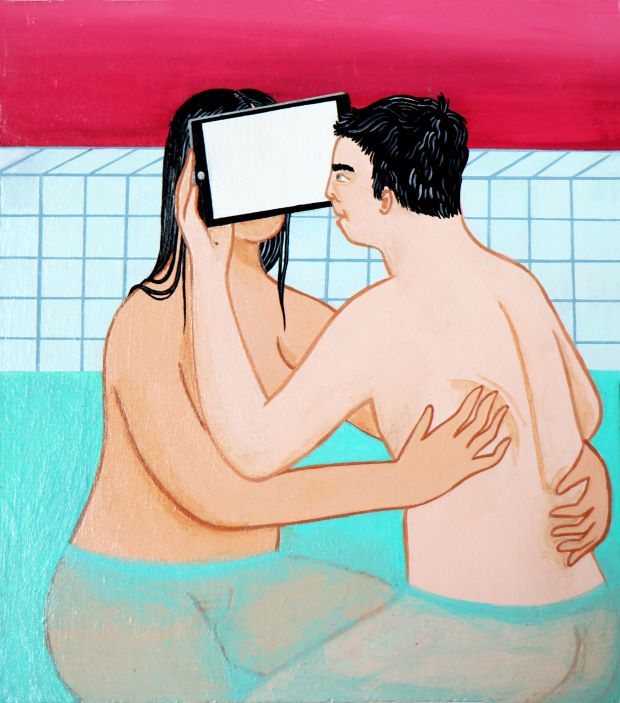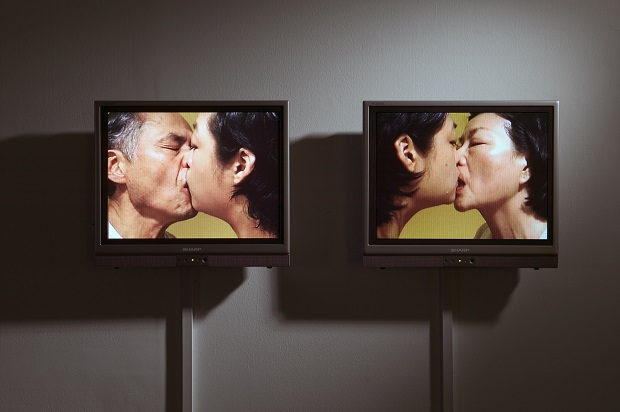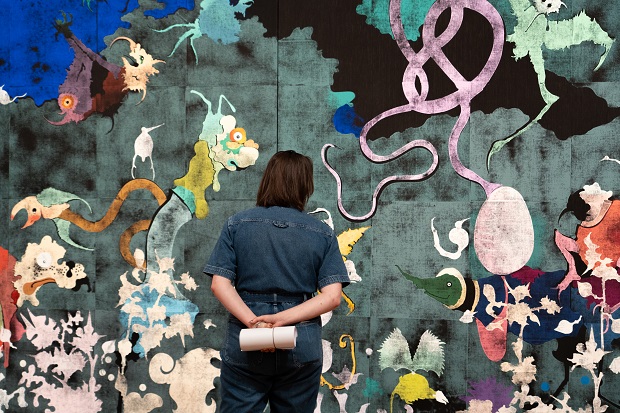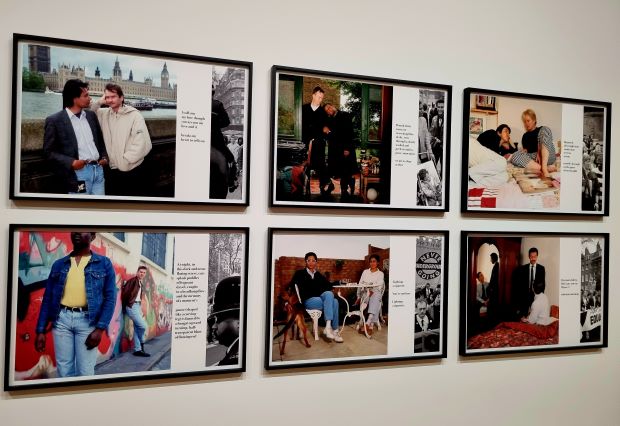- Daily & Weekly newsletters
- Buy & download The Bulletin
- Comment on our articles
Love is Louder: Bozar exhibition is a colourful, tender and expansive portrayal of human relationships
In the face of increasing disharmony and discrimination, the bold title of the exhibition Love is Louder is an appeal to “make love, not war”, according to the hippy mantra of the 1960s.
If the 1967 ‘Summer of Love’ serves as the starting point for this exploration of love between human beings, artists over the ensuing six decades have represented multifarious forms of love, from the personal to the political.
Some 120 works by 80 Belgian and international artists capture love in painting, sculpture, video, film and multimedia installations. Resolutely contemporary, the show is the first to be curated by Bozar’s new director of exhibitions Zoë Gray. “We all need more love,” she declares, highlighting the universal and accessible qualities of the exhibition.
Artworks are divided into three categories that show increasing intensities of love: intimacy and romance; kinship and friendship; community and solidarity.

Heralding the first is one of two works specially commissioned by Bozar. Brussels artist Kasper Bosmans’ large two-dimensional mural Belvedère & Boerenjongens (pictured) is a tribute to local and European history. Weaving multiple stories, he depicts the cherry orchards of his home municipality Schaerbeek that date from medieval times and are rural scenes of frolic and merrymaking. Meanwhile, the pleasure palace of the royal garden of Prague Castle rising in the background of the fresco was once home to Roman Emperor Rudolf who entertained male lovers within its secluded walls.
In ensuing galleries, romantic love is also expressed in words, a key motif throughout the exhibition, as well as objects and figures. Coupledom is represented simply but evocatively by a pair of intertwined toothbrushes in a glass by Ornaghi & Prestinari, wittily entitled Tango.

Equally symbolic and highly expressive are two suspended pink terry towelling figures caught in an embrace. Louise Bourgeois’ Couple is both an intimate and public display that reveals an ambivalence at the heart of many relationships.
In Tracey Emin’s applique blanket Not too much to ask, the artist’s trademark cut-out lettering expresses romantic expectations in calling for an international lover. It is offset by patches of vintage floral fabrics for a subversive edge to the traditional technique of quilting.
Marta Minujin’s Amor a primera vista is another textured work with assembled undulating mattresses serving as a canvas for acrylic paint to create a soft, rainbow-hued sculpture that envelops the onlooker.

A more traditional representation of a complicit moment is offered in Nathanaëlle Herbelin’s figurative painting Claire and Cécile (pictured). The portrait is staged on her studio sofa that she call the “sofa of love” and invites contemplation of the intimate domestic scene.
Alongside circular emblems symbolising all-encompassing love, there are less harmonious depictions of romantic duos, particularly in a series of compelling films and video installations. Tensions arise along with questions over how people fall in love – whatever their sexual orientation – as well as disruptions to the stereotypical power balance between men and women.

Not only has the notion of the nuclear family eroded since the 1960s, new technology has transformed dating and relationships to create interactions that are devoid of emotion. Belgian artist Joëlle Dubois underlines the transactional nature of an intimate moment in her painting (pictured, main image) of a couple where a digital screen serves as a barrier to a more meaningful relationship.
The exhibition space widens as it turns to questions of Kinship and friendship to signify the move to broader relationships. Artworks explore the equally complex dynamics between family members, from the love-hate between brothers and sisters and an idealised maternal love that also incorporates post-partum depression and the often invisible emotion of unrequited fatherhood.

A striking and at first glance shocking video installation In Love (pictured) by Patty Changshows the artist both with her mother and father. Although they appear to be passionately embracing, raising taboo questions of incest, they are in fact eating an onion by passing it from one mouth to another. This is a tear-inducing act that is screened in reverse to heighten the experience.
In an interactive work by Nevin Aladag, the artist invites viewers to reconfigure their family and their position within it via five mirrors of varying heights. Spiegelfamilie is a simple yet highly effective means of interrogating the familial roles that we occupy. It’s also humourous; the fifth short mirror is destined for the family dog.

A large painted woodcut stretches along one side of the exhibition space: a colourful but brooding abstract by identical twins Gert & Uwe Tobias that is an interpretation of the biblical story of brothers Cain and Abel. Inspired by the folklore of their native Transylvania, it underlines the ambivalent relationship that frequently exists between siblings.
The significance of friendships can sometimes be eclipsed, but the final gallery in this section heightens their importance. Fernando Marques Penteado’s installation Meet me at the finger buffet is an intriguing tableau recreating a homely display of male friendship. On the walls hang pinboard-like collections of mementoes and paintings while a table is set with drawing materials and food. Chairs are left casually askew and draped with clothes to suggest a captured moment of this reunion of close friends.

In the final chapter Community & solidarity, artworks present a portrayal of love in society. Historical pieces hark back to the revolutionary period of the late 1960s with works by Evelyne Axell – her pop art plexiglass exemplifies the freedom of the age in Joli mois de mai (pictured, main image). Yoko Ono & John Lennon, Sunil Gupta and Sam Durant are also among the influential voices on display; the latter is responsible for the exhibition’s slogan ‘Love is Louder’ (pictured).
The reality of life for the LGBTQ+ community in Lebanon is hazardous. A Hands Routine by Omar Mismar traces two men’s car journey across Beirut, depicting the moments when they can hold hands or need to release them, for example at a red light. Any public display of affection turns them into a target and raises questions about the place for gestures of love in public spaces.

American photographer Nan Goldin’s portrait of homosexual couple Gilles and Gotscho (pictured) is a reminder of the devastation of AIDS in the 80s. Her poignant series of images of the homosexual couple’s lives concludes with Gilles’ death from the disease.
The second specially-commissioned work is the site-specific sound installation by Julianne Swartz called We complete that closes the exhibition. The New York artist collected some 88 quotes from a variety of recognisable people, from Aesop and James Baldwin to Desmond Tutu and Mother Theresa. They are read out by Brussels children and teens, aged seven to 17, in French, Dutch and English.

The installation is activated by sitting on one of three benches and joining hands with another person; the act of touch triggers the electric current that connects to a loudspeaker. “It is a spoken work poem about loving community, independence, acceptance and compassion,” says Swartz.
As well as the message about the need for collaboration, the use of children’s voices is integral for the work. “They are our future and they will inherit our world,” she concludes.
For the exhibition’s curator, the show represents a positive signal that is important in the face of the uncertainty of the world. The theme is also one that has always motivated people, not least artists.
“For, as Matisse asked in 1954, “is not love the origin of all creation?” says Gray, who points out that Love is Louder is complementary to Bozar’s concurrent exhibition Hans/Jean Arp & Sophie Taeuber-Arp. Friends, Lovers, Partners. It is also accompanied by the video game space Bozar Arcade, which focuses on the theme of love and emotions in virtual worlds.
Love is Louder
Until 5 January
Bozar
Rue Ravenstein 23
Brussels
Photos: (main image) Joli-mois-de-mai by Evelyne Axell; Jasper Bosmans Belvedère & Boerenjongens ©Bozar-Marin Driguez; Louise Bourgeoise, credit Julie Pollet; Nathanaëlle Herbelin Claire et Cécile; Joëlle Dubois Anonymous; In Love by Peggy Chang; Gert & Uwe Tobias, credit Julie Pollet; Love is Louder by Sam Durant; We complete by Julianne Swartz, courtesy the artist ©Bozar-Marin Driguez



















